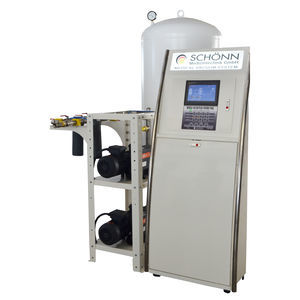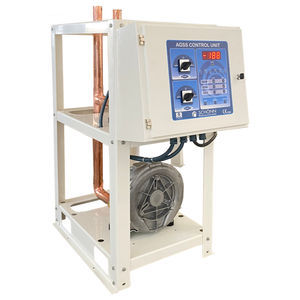
- Medical Technical Facilities
- Hospital infrastructure
- Dental vacuum system
- Schönn Medizintechnik GmbH
Dental vacuum system rotary vanedrylubricated
Add to favorites
Compare this product
Characteristics
- Applications
- dental
- Technology
- rotary vane
- Options
- lubricated, dry
- Pressure
180 mbar, 250 mbar
(2.61 psi, 3.63 psi)
Description
They are used to remove air, blood, saliva, amalgam, detritus, tooth pieces, etc. with a high flowrate using a specially designed cannula that exist during treatments. These are removed at a speed of 15-20 m/s. The solid and liquid wastes collected into the disinfection vacuum tank are released to the drainage system after disinfection process.
Dental vacuum plants are designed and produced complying with Medical Devices Directive 93/42/EEC, HTM 2022 Dental Compressed Air and Vacuum Systems, ISO 1497, ISO 13485, EN 46001 standards.
Design and flow calculations of a dental vacuum plant are done according to HTM 2022:2003 Dental Compressed Air and Vacuum Systems standard and the capacity is specified.
Dental vacuum plants comprise of dry type high capacity radial vacuum pumps, automatically controlled disinfection tanks, bacteria filters and amalgam separators designed to comply with ISO 11143 standard.
Amalgam Separator
Oil-lubricated rotary vane vacuum pumps offer high flow capacities. They are simple and economical to install and operate, and are quiet and vibration free. They provide smooth, pulse-free vacuum and have low starting and running torque.
The vanes are constructed from composite material for a long lifetime of use (up to ten years under normal operating conditions) and low noise levels.
Bacteria Filters
In dental vacuum plants bacteria filters are used that can filter particles up to 0,01μm with a DOP efficiency of 99,9999%.
Disinfection Tanks
According to the plant capacity two automatically controlled tanks are used. These tanks work synchronously under control of the automatic control panel.
Catalogs
No catalogs are available for this product.
See all of Schönn Medizintechnik GmbH‘s catalogsOther Schönn Medizintechnik GmbH products
Medical Gas Plants
Related Searches
- Medical gas outlet
- Manifold
- Medical gas manifold
- Vacuum system
- Medical vacuum system
- Anesthetic gas alert system
- DIN outlet
- Plug-in type vacuum regulator
- Medical gas medical alert system
- Automatic manifold
- Lubricated vacuum system
- Dry vacuum system
- Rotary vane vacuum system
- Changeover manifold
- High-pressure manifold
- Manual manifold
- Dental vacuum system
- Modular vacuum system
- Electronic vacuum system
- Manual vacuum system
*Prices are pre-tax. They exclude delivery charges and customs duties and do not include additional charges for installation or activation options. Prices are indicative only and may vary by country, with changes to the cost of raw materials and exchange rates.







